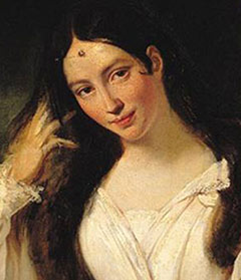Follow @euroaahrefhttpapolloramacukemuwebpagesramdisplayphpirn10689target_blankpavox
María Malibran. Oil on canvas by an unknown author. Royal Academy of Music. London.
María Felicia Rodríguez Sitches, known, after her first husband’s name, as Maria Malibran, was one of the most celebrated prime donne during her brief life and in the whole history of opera. Multiple contemporary testimonies left by aficionados and musicians invariably describe her voice as an extremely rich one, while they rarely fail to characterise her as a gifted actress on the operatic stage.
According to her brother, Manuel Patricio García, singing maestro at the London Royal Academy of Music and the author of the Complete treatise on the art of singing (Paris 1840-1847), her tessitura was exceptionally long (flat E2-C4). Other testimonies state her top notes went up to a top E5 (sovracuto), encompassing a bright head register complemented by a mellow -and nevertheless powerful- voce di petto (chest register). The same as her brother and younger sister, the contralto Pauline Viardot-García, she received her first lessons from her father, the celebrated tenor and singing master Manuel del Pópulo García. As neither Maria, nor Manuel del Pópulo had a calm or retiring personality -quite the opposite, in fact- these lessons have been described by those who had a chance to observe them as tumultuous. However talented, Manuel del Pópulo’s personality was choleric and even violent, which often pervaded the relationship with his elder son and daughter. However, his singing technique and methods where in the end effective, and his demanding manners proved successful, especially in María and Pauline’s cases, as both of them became in turn celebrated professional opera singers.
According to María’s brother, Manuel Patricio, the most extraordinary aspect of her flawless technique were not her top notes, but her ability to explore all the potential of the different vocal registers, especially the chest one, which she employed, for instance, as she had to sing Rosina’s lines “Una voce poco fà/ chi nel cor mi risuonò”, in her aria from Rossini’s Il barbiere di Siviglia. Sadly enough, as her career ended before the early methods of sound recording were invented, there are no extant proofs of why her voice may have impressed her contemporaries to such a degree.
She performed Rosina at several European theatres, as well as during the first operatic season ever celebrated in the United States, in 1825, as part of the García troupe conducted by her father. Other roles in her repertoire were Rossini’s Desdemona (Othello) and Semiramide (title role), Bellini’s title role in Norma and Sonnambula, Donizetti’s title role in Maria Stuarda, Mozart’s Zerlina (Don Giovanni) and many others, including several trousers’ roles.
Mozart’s Zerlina (Don Giovanni) and many others, including several trousers’ roles.
Her education at a London school, as well as the time spent in Italy and in Paris in her early youth, plus her Spanish origin and family, allowed her to feel at home in any of these countries and cultures later on in her life. It was her home in Brussels, however, the one which she considered as her refuge.
François Bouchot. María Malibran characterised as Desdemona
for Rossini’s Othello. Oil on canvas. Paris. Musée de la vie romantique.
She was one of the most renowned protagonists at theatres such as the London Haymarket, the Teatro alla Scala (Milano) and the Théâtre des Italiens, in Paris, where she was labeled as a worthy heiress for the prima donna Giuditta Pasta.
She has often been described as a prototypical romantic heroine although, from the current perspective, her trajectory may be more easily recognised as that of a modern woman. Strong-willed, economically, intellectually and emotionally independent, and faithful to the end to her professional role, she died only days after her last operatic performance. She could even be described as a “post-modern” artist avant la lettre, if it was not because her first commitment was with her concept of truth and emotional authenticness. She may not have fulfilled the ideals of the bourgeois society of her time, but she did defend this truth in the operas she performed, as well as in the professional commitment with both fellow musicians and with the public. A contemporary anecdote describes how she became an early symbol of the Italian liberal and proto-national ideas as she refused to change one line in her performance of Donizetti’s Maria Stuarda, stating that only the composer could effectively order such a modification.
After her first marriage was considered null, she married the violinist Charles-Auguste de Bériot, which whom she had lived for the past six years. Their son, Charles Wilfrid, born in 1833, would in turn become a piano virtuoso, having Maurice Ravel among of his disciples.
You are welcome to quote this text using MLA guidelines for scholarly articles and websites.

